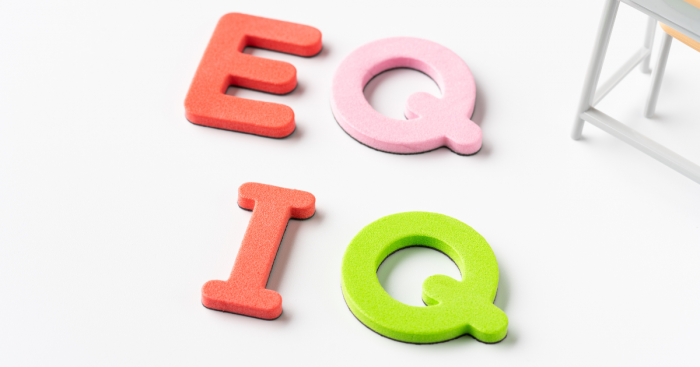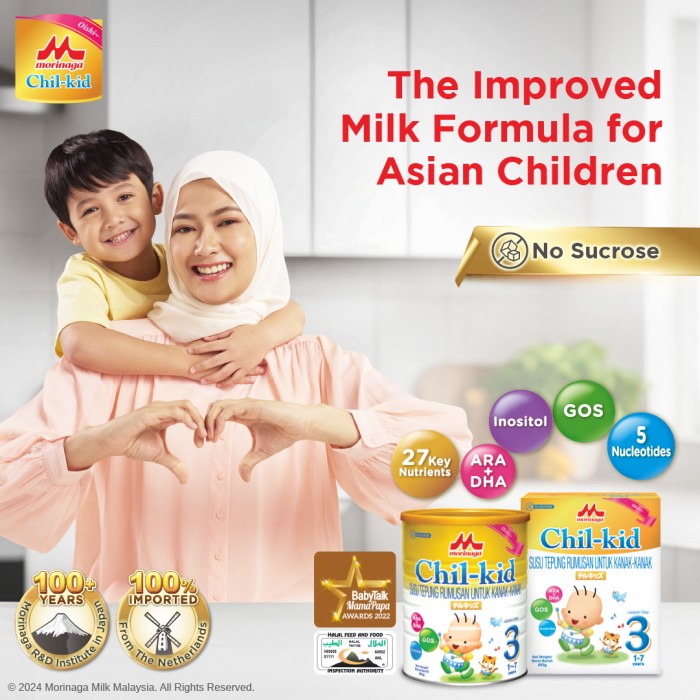As parents, we all want our children to be successful in life. That is why we always tell them to study hard and do well in academics so that when they grow up, they will be successful in their chosen careers later in life. We often equate IQ development with success but did you know that EQ can have a greater influence on a person’s success[1] in life than IQ?
What is EQ?

IQ, as everybody knows, stands for Intelligence Quotient which is a measure of a person’s intelligence in logic and reasoning. A child’s IQ is a good gauge of how well he will do in school. EQ[2], on the other hand, stands for Emotional Intelligence or Emotional Intelligence Quotient which is the ability to understand, use and manage one’s own emotions while understanding the emotions of others. It helps a person communicate effectively while empathizing with others, overcome challenges, defuse conflict, build stronger relationships and succeed in school, career and personal goals.
EQ was first popularized by science journalist Daniel Coleman who arrived at this concept through a research[3] by two university psychologists Peter Salovey and John Mayer who said that the five main aspects that determine a person’s EQ include:
- Self-Regulation
- Social Skills
- Motivation
- Self-Awareness
- Empathy
Signs of High EQ
People, including children, who have high EQ:
- Are able to recognise and understand what one is feeling and what others are feeling
- Have self-confidence and self-acceptance
- Have empathy for others
- Are sensitive to the feelings of others
- Are aware of one’s own strengths and weaknesses
- Care about and are interested in others
- Take ownership of one’s own shortcomings and mistakes
- Have the ability to learn from mistakes and let them go
- Are able to embrace changes and transitions in life and flow with them
Why is EQ important to Children?

A: Naturally, this means children with high EQ can build better and stronger relationships[4] with others. Because they are smart about their emotions and smart about handling other people’s emotions, they can get along with others well, manage conflict better, are able to stay calm when they are angry instead of being obstinate and flying off the handle, are collaborative and manage challenges in all areas of life in a healthy way. Being empathic, they can understand the other person’s point of view and respect their emotions.
B: Children with high levels of EQ perform better at school. This is because they will be more engaged in their lessons and activities and pay attention in class. This means that high EQ is linked to high IQ[5].
C: Children with high levels of EQ are also more likely to achieve greater success when they reach adulthood. According to this study[6], kindergarten children who were able to share, cooperate and follow directions at age five were more likely to obtain college degrees and begin working full time jobs by the time they reached age 25.
D: Lastly, individuals with higher EQ are likely to enjoy better mental health[7] as they are less likely to experience depression, mood and anxiety disorders and other mental issues.
As can be seen, EQ can have a greater influence on one’s success in life than IQ[8].
How to Raise your Child’s EQ

Helping your child raise his or her EQ can and should be started from young. Here are six tips to incorporate into your daily activities to help boost your child’s emotional intelligence.
1: Teach Children about Emotions
Babies and very young toddlers have very little understanding of their emotions and very little concept of social cues and situation. That is why it is normal for two-year-olds to throw tantrums. They don’t understand why they are feeling frustrated or angry and will have a meltdown if their needs or wants are not met.
A good place to start teaching them about how to recognise what they are feeling[9] by identifying them. There are six primary emotions[10] that are the easiest to identify and display and hence easiest to teach, according to psychologist Paul Ekman. The six emotions are:
- Happiness
- Sadness
- Fear
- Surprise
- Disgust
- Anger
Teaching children about these six primary emotions can be made into a fun game by using drawings or paper plate masks. When they are upset that they have to share a toy or they are excited that you will be taking them to a theme park, You can ask them how they are feeling and they can hold up the masks to show you. Later, you can build on these six emotions for other emotions such as “upset”, “jealous”, “excited”, “hopeful” and so on. This way, they get to learn that there’s a name for each of their feelings and that they can talk about them. You can prompt them to talk about these emotions by asking, “Why do you feel this way.” The more you talk about emotions, the more they will understand and manage them.
By the time children are three years old, they should be able to correctly label, recognise as well as identify their emotions in different situations.
2: Practice Reading Emotions in Others
Watching TV or a video of a movie, reading a bedtime story can be a great way to teach children about reading social cues[11]. Pause the video or stop midway during reading and ask your child to guess how the characters are feeling and why they are feeling this way. Explain how body language and facial expressions can be clues.
For example, you can tap your fingers, shrug your shoulders, fidget, stand with your hands on your hips and ask them or explain to them the unspoken messages behind each of these movements. You can tell them – “When someone is standing like this, it can mean that they are losing the patience,” and so on.
You can also use pictures to do this. Show how eyebrows, mouth, eyes, nose and forehead convey emotions. You can make “angry eyes” or a “happy face” and tell your child to make this expression in the mirror to see how accurate this expression is. This can help them to see it in other people’s faces. This way they learn to see facial expressions and read them[12].
3: Show Empathy
When your child is upset and is throwing a drama, don’t dismiss or minimise what they’re feeling. Instead, validate their feelings and show empathy[13]. If your child is crying because you told them they cannot go to the park until they pick up all their toys, say something like, “I feel upset too when I don’t get to do what I want. It’s hard sometimes to have to go to work every day when I don’t want to.”
When your child sees that you understand how they’re feeling inside, they will feel less compelled to scream and cry to show you that they’re angry because you have made it clear you understand they are upset.
Another example would be seeing your child having a complete meltdown over a misplaced toy truck. Instead of telling him to “relax” or “forget about it”, tell him you understand how frustrating it is to lose something that’s important to him.
4: Nurture Empathy
Finding ways to help others[14] can help your child build empathy. You and your child can join a volunteer effort to help the needy or simply work together to help someone in need. The goal is to be a role model and show how to be kind, loving and charitable.
For example: “Jason tripped and dropped his plate of food. Let’s help Jason clean up.”
You can also talk about the feelings of others. For example: “Atiqah is feeling sad because you took away her teddybear. Please give Atiqah back her teddybear and then you can choose another toy to play with.”
Yet one more way is to ask – “how would you feel?”[15] When your preschooler hits a sibling or a friend or takes away the toy they are playing with, you need to explain that such behaviour can hurt a person physically and emotionally. Try saying something like, “How would you feel if someone took your toy away?” or “How would you feel if someone hit you?”
5: Teach Healthy Coping Skills
Once children have put a name to the emotions they are feeling, they need to learn how to deal with them in a healthy way[16]. They must learn how to calm themselves down, cheer themselves up or face their fears.
This can be a huge task for young children.
Teach them specific skills such as how to calm down when they are angry. An example would be to teach them to how to take “bubble breaths” where they breathe in through their nose and blow out through their mouths as if they were blowing a bubble through a bubble wand.
Another method is to create a “calm down kit” that includes a colouring book, a favourite joke book, a musical instrument like a harmonica or a recorder so that they can create tunes or lotions that soothe the senses. Put all of this into a box which they can decorate. Whenever the child is angry or upset, you can remind them to get the kit to manage their emotions.
Other coping methods might include watching a comedy programme, lying down or engaging in positive self-talk[17] such as telling oneself: “I can do this,”, “I will do well on this test”, or “I can make the team” and so on.
6: Nutrition Develops High EQ
This last point may sound surprising but did you know that nutrition impacts cognition and emotion?[18] For young, fast-growing children, nutrition plays a very important role in all-round development and this includes the brain.
When babies are born, the basic structure of the brain is formed although it is only a quarter the size of the adult brain. Over the course of time, the brain will continue to develop, form synapses and neural networks, refine itself and mature until it completes its growth during early adulthood. The brain’s fastest growing stage is during the first five years of a child’s life. From a quarter the size of the adult brain at birth, the brain grows to 90% of its adult size by age five[19]. This is why receiving proper nutrition that enables optimum brain development is of paramount importance to a young child.
While it is a given that nutrition supports brain function and development, nutrition also supports EQ development[20]. After all, emotions, moods, behaviour as well as learning, memory and academic intelligence come from the same place − the mind. “A healthy mind starts with a healthy body”, as the saying goes, and a healthy body starts by giving it the right nutrition.
In terms of the brain itself, it is 60% fat while the rest is a combination of water, protein, carbohydrates and salts[21]. Running throughout the brain are blood vessels and nerves including neurons and glial cells that need sufficient amounts of glucose (a type of sugar) to function properly. Glucose comes from the food we eat. This is why some of us experience headaches, double vision, fatigue and dizzyness when our blood sugar drops too low from not having eaten enough[22].
For young, growing children, not getting sufficient amounts of the right nutrients especially good fats such as Omega-3 polyunsaturated fatty acids[23] can lead to cognitive and physical impairment such as stunting, depression, low immunity, poor behaviour, poor memory, sleep issues, anxiety and poor school performance.
Omega-3 polyunsaturated fatty acids include a-linolenic acid (ALA) and docosahexaenoic acid (DHA) among others. DHA is essential for brain growth, function and development[24] of infants and children and its inclusion in their daily diet improves learning ability and cognitive function.
If a child is always falling sick, is weak, and has sleep, mood and behavioural issues due to a poor diet, it stands to reason why his EQ development may be compromised.
This underscores why children must be provided with complete nutrition encompassing a wide variety of foods and good fats that the brain needs to develop and function optimally.
Morinaga Chil-kid

Morinaga Chil-kid is a Japanese growing up milk that is packed with over 45 essential nutrients such as ARA, DHA, GOS, five Nucleotides, Omega 3&6 LCPs and 27 vitamins and minerals that ensure children receive optimal nutrition during their fast-growing years.
Designed specially for Asian children aged one to seven, the milk is formulated in a balanced ratio of protein, fat and energy to help children achieve their daily Recommended Nutrition Intake (RNI) when taken alongside their meals.
Morinaga Chil-kid has a subtle vanilla taste and no added sugar making the formula less sweet but more OISHI for children’s acceptance.




